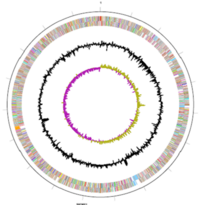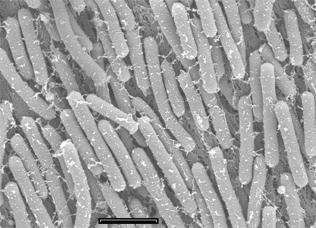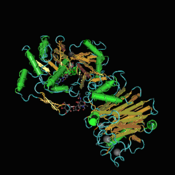Haliangium ochraceum
Classification
Bacteria, Proteobacteria, subdivisions: deltaproteobacteria, Myxococcales, Nannocystineae, Haliangiaceae, Haliangium, Haliangium ochraceum
Species
|
NCBI: Taxonomy |
Genus species: Halangium ochraceum DSM 14365, Halangium ochraceum SMP-2
Description and Significance
Haliangium ochraceum is a rod-shaped myxobacterium that is motile through gliding. It is pale yellow in color and approximately 0.5-0.6 um in diameter and 4.0-4.5 um in length [5]. It was named according to the Greek roots halios, "from the sea," angium for "vessel," and ochros for "pale yellow." The strain was isolated in Kanagawa, Japan, from sea grass samples, and cultured in a lab setting for analysis [5].
Haliangium ochraceum is an obligate halophile, meaning that it requires a saline environment. The minimum NaCl concentration required for growth was determine to be 0.2%, with growth in p to 5% NaCl environments [6]. Optimal growth conditions were 2% NaCl [5]. H. ochraceum is a chemoautotroph and grows in aerobic conditions.
H. ochraceum is the first myxobacterium of its kind to be found in the ocean; it is the first halophilic myxobacterium. No related microbes are known in soil environments [6]. H. ochraceum's unique presence has prompted a novel phylogenetic genera, and suggests that it could have evolved from a separate group than most other myxobacteria.
Genome Structure
"H. ochraceum is an aerobic, obligate halophilic gram-negative myxobacterium isolated from seaweed... Myxobacteria are unicellular bacteria that are characterized by complicated multicellular behaviors, such as feeding, social movement, aggregation, and fruiting body formation, which make them highly unusual. [6]"
H. Ochraceum has a distinct way of protecting its DNA against viruses and foreign DNA. Its DNA contains hundreds of repeated base pairs called CRISPR units [3]. (See "Ecology and Pathogenesis," below).
Chromosome: circular
Sequence: RS: NC 013440
Length: 9446314
Number of Nucleotides: 9446314
Number of Protein Genes: 6719 (DSM strain)
Number of RNA Genes: 55 (DSM strain)
[7]
Cell Structure, Metabolism and Life Cycle
Cell Properties:
Membranes: 2
Color: pale yellow
Shape: rod
Motile: yes, gliding
Flagella: yes
Reproduction: sporulation
Base pairs: 9446314
Human pathogen: No
[4,5,6]
Haliangium ochraceum is a chemoorganotroph, it gains its energy through organic chemical processes. Myxobacteria are particularly known for their synthesis of secondary metabolites. H. ochraceum is currently under study for its production of haliangicin, a possible antifungal and antibiotic compound.
Life Cycle:
Haliangium ochraceum, as a myxobacterium, is a single celled organism that participates in a complex multicellular group, or swarm. They glide, as a group, along a solid substrate and digest molecules or microorganisms as a unit. [6,8] "H.ochraceum develops a few fruiting body-like structures in the center of a swarm and grows in tight clumps. Its growth is very dependent on cell density [6]."
When conditions become harsh, H. ochraceum aggregates into this swarm and forms a fruiting body. As the body sporulates, some cells become rounded and have thicker cell walls. These cells, called spores, are meant to survive the harsh conditions until nutrients become available again.
Ecology and Pathogenesis
The habitat of Haliangium ochraceum is a marine, coastal, sand. It can be found anywhere with a concentration of salt five times greater than the salt concentration of the ocean and grows best in 30 to 35°C. [1]
Haliangium ochraceum has not been known to cause any disease within animals, plants, or humans. However, this microorganism is being researched for its ability to become a antifungal metabolite and antibiotic. Haliangicin is a beta-methoxyacrylate-type polyene antibiotic isolated from the unique marine myxobacterium Haliangium ochraceum. A further investigation of the extract of this microorganism has resulted in the isolation of haliangicin as well as its geometrical isomers.[Kundim,B.A., et.al] The major isomer, cis-haliangicin, is a cis isomer of the epoxide portion of haliangicin.[Kundim,B.A., et.al] (The marine myxobacterium Haliangium ochraceum,51 originally H. luteum,yielded several new isomers of the polyene antifungal antibiotic haliangicin.52,53 These are cis-haliangicin 20 and haliangicins B–D 21–23, geometrical isomers of the polyene and epoxide moieties. The stereochemistry of the epoxide in the known haliangicin 2453 has been determined as 135 trans. All of the haliangicins were active against the phytopathogenic fungus Phytophthora capsici. [Blunt, J.W. et.al]
There have been some novel findings, including the first actin in bacteria (left). Actin is a protein that forms a structural framework inside all eukaryotic cells, allowing cells to crawl and to arrange and move items around internally. Previously, the protein had been thought to exist only in eukaryotic cells. The survey found a structurally similar molecule in the marine bacterium Haliangium ochraceum. The authors hypothesize that the bacterium may use the actin-like protein to make a toxin that attacks other cells. [2]
H. ochraceum also contains hundreds of DNA repeats called CRISPR units. CRISPR is a recently discovered “immune system” that protects bacteria from viruses and other foreign DNA. The CRISPR array in H. ochraceum is by far the largest yet found. The microbes for the study were grown by a team led by Hans-Peter Klenk of the German Collection of Microorganisms and Cell Cultures (also known as the DSMZ). [3]
'
References
1. Kundim, B.A, Itou, Y., Sakagami, Y., Fudou, R., Iizuka, T., Yamanaka, S., and M. Ojika. (2003). "New haliangicin isomers, potent antifungal metabolites produced by a marine myxobacterium". The Journal of Antibiotic (Tokyo). 2003 Jul;56(7):630-638.
2. Fudou, R., Iizuka, T., and S. Yamanaka. (2001). "Haliangicin, a novel antifungal metabolite produced by a marine myxobacterium. 1. Fermentation and biological characteristics". The Journal of Antibiotic (Tokyo). 2001 Feb;54(2):149-152.
3. Zhang, Y.Q., Li, Y.Z., Wang, B., Wu ZH, Zhang, C.Y., Gong, X., Qiu, Z.J., and Y. Zhang. (2005). "Characteristics and living patterns of marine myxobacterial isolates". Applied Environmental Microbiology. 2005 Jun;71(6):3331-3336.
4. Fudou, R., Jojima, Y., Iizuka, T., and S. Yamanaka. (2002). "Haliangium ochraceum gen. nov., sp. nov. and Haliangium tepidum sp. nov.: Novel moderately halophilic myxobacteria isolated from coastal saline environments". General Applied Microbiology. 2002. Volume 48. Number 2. P. 109-115.
5. Lucas, S., Copeland, A., et. al. "The complete genome of Haliangium ochraceum type strain (SMP-2t)." Standards in Genomic Sciences. 2009. 2: p96-106.
6. "HAMAP: Haliangium ochraceum complete proteome." Expert Protein Analysis System. Swiss Insititute of Bioinformatics. 4-9-2010. <http://expasy.org/sprot/hamap/HALO1.html>
7. "KEGG Genom: Haliangium Ochraceum." Kyoto Encyclopedia of Genes and Genomes. 4-20-2010. <http://www.genome.jp/kegg-bin/show_organism?org=hoh>
8. Dworkin, Martin. "Myxobacteria." University of Minnesota Microbiology Department. 4-21-2010. <http://myxobacteria.ahc.umn.edu/>.
Author
Page authored by Alyse Egner and Melissa Erickson, students of Prof. Jay Lennon at Michigan State University.




